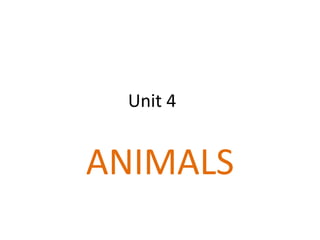
Unit 4 - Animals
- 2. Vertebrates Animals with bones are called vertebrates. Mammals, tortoises, birds, fish and lizards are vertebrates.
- 3. Invertebrates Animals without bones are called invertebrates. Flies, snails, crabs, ants and butterflies are all invertebrates. snail crab fly ant butterfly
- 4. What do animals eat? Animals which eat plants are hervibores. They eat grass, leaves, flowers, fruit and vegetables. Hippo Panda bear Zebra sheep
- 5. What do animals eat? Animals which eat other animals are carnivores. They can eat insects, fish or other animals they catch. lion chameleon cheetah shark
- 6. What do animals eat? Animals which eat meat, fish and plants are omnivores. Humans, chimpanzees, hedgehogs and pigs are examples of omnivores.
- 7. Mammals All mammals are vertebrates. They have bones. They are born live. Mammals are born from their mother´s womb. Baby mammals drink their mother´s milk. Their body is covered with hair. Most mammals have four legs and can walk...
- 8. Now think... Can you think of some mammals that can not walk? Can you think of a mammal that can fly? Can you think of a mammal with two legs?
- 9. Whales and Dolphins are mammals. They don´t have hair. They can not walk, but they can swim and jump.
- 10. Bats are mammals. They can fly.
- 11. Humans are mammals. We only have two legs, but we can walk and run.
- 12. Birds Birds are vertebrates. They have bones. They are born from eggs. Their bodies are covered with feathers. They have wings and a beak. Most birds can fly... Tail Beak Wings
- 13. What birds do you know? Duck Flamingo Toucan Parrot Eagle Owl storke
- 14. And now some birds that can not fly... Peacock Penguin Ostrich
- 15. Fish Fish are vertebrates. They have bones. They are born from eggs. Their bodies are covered in scales. Fish have fins to swim. Fins Tail
- 16. Reptiles Reptiles are vertebrates. They have bones. Reptiles are born from eggs. Their bodies are covered in scales like the snakes or have a shell like the tortoises. They are cold- blooded animals. They need sunshine to stay warm.
- 17. Reptiles Snake crocodile Tortoise Lizard
- 18. Snakes Snakes have scales. They have no legs. All snakes are carnivores. They smell with their tongue.
- 19. Crocodiles Crocodiles are large reptiles. They have scales. Crocodiles are carnivores. They have four legs.
- 20. Which is your favourite animal? Pick you favourite animal from this web page: http://www.dltk-kids.com/animals/manimalposter.html Print your animal and colour it.
- 21. Investigate your favourite animal Answer the following questions: Is your favourite animal a mammal, a fish, a bird or a reptile? Is it a vertebrate or an invertebrate? What does it eat? Where does it live? Is it born life or is it born from eggs? What can it do?.....